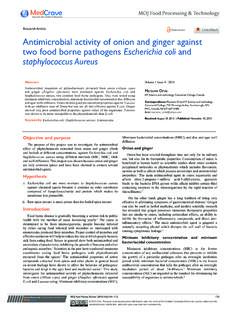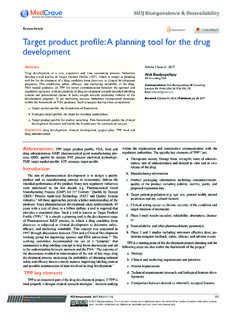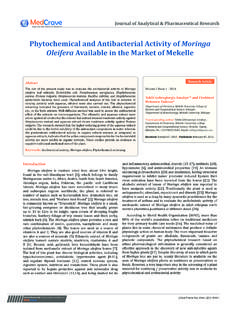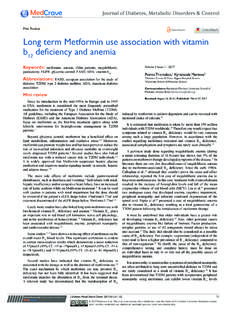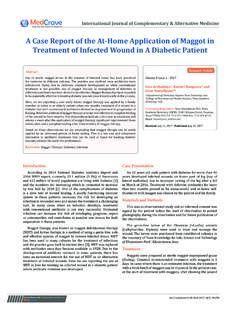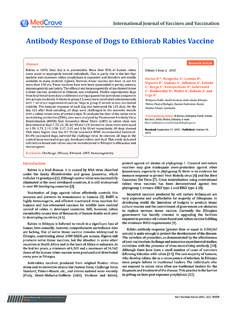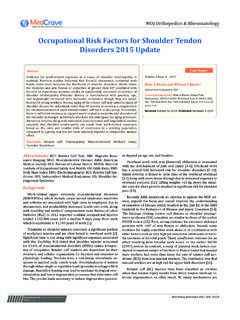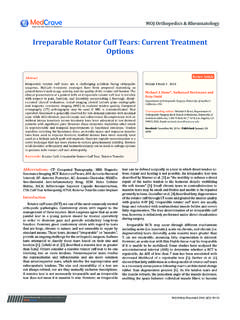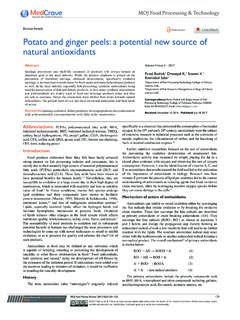Transcription of Studies on recombinant lipase production by E. Coli ...
1 Submit Manuscript | (triacylglycerol acylhydrolase, EC ) are versatile enzymes with multiplexity of catalysis and therefore, constitute an important class of industrial enzymes in basic and applied research. They are part of the serine hydrolase family that acts on carboxylic ester bonds of tri-, di- and mono-glycerides and converts them into fatty acids and glycerol. According to recent surveys, by 2020 the lipase market is estimated to reach about $ million, at a CAGR of from 2015 to The potential of this enzyme as biocatalyst is literally boundless in many industries because of many characteristics like high stability in organic solvents, broad range of substrate specificity, high regio- and/or stereo-selectivity in catalysis and ability to act under mild Microbial lipases are the most useful ones as compared to the lipases from plant and animal origin because of high yield, ease of genetic alteration, broad range of catalytic activities.
2 Variety and tolerance to environmental conditions, regular supply due to absence of seasonal fluctuations and along with that fast growth rate of microbes in comparatively less expensive The most preferred microbial sources used in the industry for production of lipases are bacterial and fungal sources. Among the extracellular lipase producing bacteria, the most important genus that have been exploited are Achromobacter,4 Alcaligenes, Arthrobacter, Bacillus,5 Burkholderia, Chromobacterium,6 Staphylococcus,7 Lactobacillus, Streptococcus,8 Micrococcus, Propionibacterium. Several Bacillus lipases have been applied biotechnologically due to their ,10 Bacillus lipases have been isolated from various type of sources ranging from hot springs,11 to polluted areas in Port Dickson12 and salty Due to such a wide range of origin Bacillus lipases exhibit different features including thermophilic,14 hyperthermophilic, psyrophilic,15 alkalophillic,16 acid thermo tolerant17 and organic solvent ,19 Though several proteins are being produced at commercial scale by the native strain, but the production of recombinant proteins still poses a challenge in many cases.
3 High production cost of any enzyme restricted its usage at large scale. optimization to increase the lipase production , without increasing the cost, is very important. Few strategies that can be adopted to reach the goal are changing expression host cells and expression vector/promoter, optimization of media composition, addition of some components to growth media, optimization of culture conditions etc. Many Bacillus lipases had been cloned, expressed, purified and characterised to an extent until 22 Various Studies has been carried out to optimise the production of recombinant proteins in E. Coli by changing media 25 Some Studies have also been carried out to optimise the expression system and host cells for the production of recombinant proteins in heterologous , 26, 27A lipase gene had been cloned from Bacillus sp.
4 By Khurana et al.,28 This recombinant protein demonstrated activity at broad pH and optimum activity at 35 C. In addition, this enzyme showed activity at low temperature and tolerance to various organic solvents. The enzyme might be a good candidate for industrial applications. Therefore, in the current investigation, an effort was made to optimize the production of this recombinant Bacillus lipase in E. Coli with respect to host strain, surfactant, media and different expression vectors in shake flask and methodsChemicals, bacterial strains and plasmids All the chemicals and reagents used were of analytical grade and purchased from MERCK (Germany) and Hi Media (India).
5 lipase substrate para-nitrophenyl laurate (C12) was purchased from Sigma Chemicals Co. (USA). All the E. Coli host cells used in the study were procured from MTCC, IMTECH, and Chandigarh, India. The plasmids used in the study were purchased from Promega, USA (pGEMT) and Qiagen, Germany (pQE-30 UA and pET28a). Antibiotics, IPTG and X-gal were purchased from Hi Media (India).Int J Mol Biol Open Acces. 2017;2(1):17 2317 2017 Khurana et al. This is an open access article distributed under the terms of the Creative Commons Attribution License, which permits unrestricted use, distribution, and build upon your work on recombinant lipase production by E. Coli: effect of media and bacterial expression system optimizationVolume 2 Issue 1 - 2017 Khurana J, Pratibha, Cameotra SS, Kaur JDepartment of Biotechnology, Panjab University, IndiaCorrespondence: Jagdeep Kaur, Professor, Department of Biotechnology, BMS Block-1, Sector 25, Panjab University, Chandigarh 160014, India, Tel (0)0172-2534085, Fax + 91-172-2541409, Email Received: November 10, 2016 | Published: January 23, 2017 AbstractRecombinant protein production is a vast field growing larger in each passing year due to continuous emergence of new host, vectors and techniques for cloning and expression .
6 Earlier, a Bacillus lipase gene was cloned in pGEMT/ E. Coli DH5 with 12 units/ml lipase production . In the present investigation, attempt has been made to optimize the production of recombinant lipase by E. Coli by varying different parameters. Amongst the different strains of E. coli, M46 cells were observed to be the best host with 19units/ml lipase production . Addition of surfactant and changing media to nutrient broth lead to fold and fold respective increase in lipase production . Amongst different vectors, pET 28a vector showed the highest total lipase production but it proved toxic for the cells, while pQE30-UA vector gives 5 fold enhanced total lipase production with more stable expression .
7 With the combination of optimized host, vector, surfactant and media, 18 fold increases in lipase production (214units/ml) was : lipase production , e. coli, host, vector, enzyme activity, surfactant, promoter, optimisationInternational Journal of Molecular BiologyResearch articleOpen AccessStudies on recombinant lipase production by E. Coli: effect of media and bacterial expression system optimization18 Copyright: 2017 Khurana et : Khurana J, Pratibha, Cameotra SS, et al. Studies on recombinant lipase production by E. Coli: effect of media and bacterial expression system optimization . Int J Mol Biol Open Acces. 2017;2(1):17 23. DOI: conditionsThe E.
8 Coli cells were grown in Luria Bertani medium (LB), pH at 37 C, 180rpm. The micro-organisms were inoculated (1%) in production medium (LB, 2% w/v) containing suitable antibiotic. The cells were induced with mM IPTG at start of the assayThe enzyme activity was determined according to the modified method of Singh et To 700 l of 50mM phosphate buffer (pH ), 100 l of sodium deoxycholate (10mM), 100 l of enzyme and 100 l of 2mM p-nitrophenyl laurate were added. The reaction was carried out at 37 C for 10min, after which 250 l of M Na2CO3 was added. The mixture was centrifuged for 5min and the activity was determined by measuring absorbance at 420 nm.
9 One unit of enzyme activity is defined as the amount of enzyme, which liberates 1 mole of p-nitrophenol from pNP-laurate per min under standard assay conditions. All the experiments were performed in triplicate and mean and standard deviations were dependent lipase productionA range of E. Coli host cells (M-46, X42, DH5 , JM109, M-15, M390, M1668 and BL21) were checked for lipase production . Competent cells were prepared of all the strains and transformed with pGEMT-lip plasmid by heat shock method at 42 C for 90sec. Supernatant and pellet of the overnight grown culture of transformed cells were assayed for the lipase production using standard assay condition and relative enzyme activity was calculated.
10 DH5 cells transformed with pGEMT-lip plasmid were served as the control. effect of different nutritional media on lipase production pGEMT lip/M46 cells were grown in four nutritional media nutrient broth (NB), Luria-bertani broth (LB), YT media and SOB media for 24h. Supernatants of cultures were assayed for lipase production to check the effect of these nutritional media on lipase of surfactant on lipase productionThe surfactant used in this study was a rhamno lipid. pGEMT-lip / M46 cells were grown in culture media (2% w/v LB) with varying concentration ( , , , 1 and ) of surfactant for 24h. Assay for lipase activity was carried out at an interval of 3 h and relatively compared with the control media (no surfactant added).
